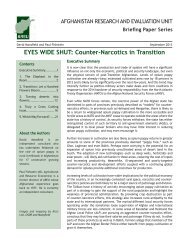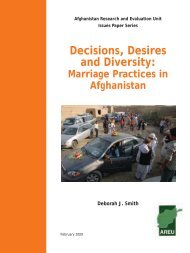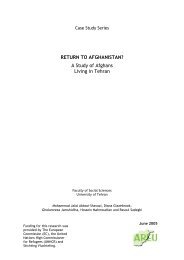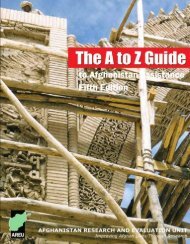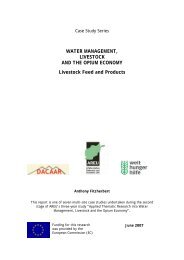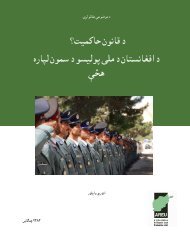Local Governance in Afghanistan: A View from the Ground
Local Governance in Afghanistan: A View from the Ground
Local Governance in Afghanistan: A View from the Ground
- No tags were found...
You also want an ePaper? Increase the reach of your titles
YUMPU automatically turns print PDFs into web optimized ePapers that Google loves.
<strong>Afghanistan</strong> Research and Evaluation Unit<br />
2011<br />
The prov<strong>in</strong>cial councils have been charged with a responsibility to create a l<strong>in</strong>k between government and<br />
<strong>the</strong> people. The research found no evidence of prov<strong>in</strong>cial councils hav<strong>in</strong>g developed communication<br />
policies to <strong>in</strong>form <strong>the</strong> public about government actions or mobilis<strong>in</strong>g responses towards a particular<br />
policy. In a number of <strong>in</strong>stances <strong>the</strong>re was evidence of council cooption, not <strong>in</strong>frequently l<strong>in</strong>ked to<br />
graft. There was thus a gap between <strong>the</strong> way that local government policy was be<strong>in</strong>g conceived<br />
and articulated by IDLG and <strong>the</strong> way that prov<strong>in</strong>cial council members were able to understand <strong>the</strong>ir<br />
function and duties and thus how <strong>the</strong>y chose to apply <strong>the</strong>m.<br />
6.2 District representation<br />
There is no universally applied system for district representation <strong>in</strong> <strong>Afghanistan</strong>. The subnational<br />
governance policy paper f<strong>in</strong>alised by IDLG <strong>in</strong> spr<strong>in</strong>g 2010 describes <strong>the</strong> nature of district governance<br />
and provides district councils with similar powers and duties at <strong>the</strong> district level as prov<strong>in</strong>cial councils<br />
have at <strong>the</strong> prov<strong>in</strong>cial level. 86 While <strong>the</strong> policy paper states that elections will take place <strong>in</strong> 2010<br />
and that <strong>the</strong> district councils will receive sufficient fund<strong>in</strong>g to undertake <strong>the</strong>ir mandated tasks, no<br />
elections have yet been organised. Respondents cited <strong>the</strong> expense and complexity of <strong>the</strong>se elections<br />
as a barrier to <strong>the</strong>ir implementation, along with <strong>the</strong> need to identify clear boundaries between<br />
certa<strong>in</strong> districts.<br />
Despite <strong>the</strong> absence of a standardised form of district representation, <strong>the</strong>re were various forms of<br />
organisation operat<strong>in</strong>g at <strong>the</strong> district level. The development role of <strong>the</strong> DDA has been noted <strong>in</strong> Section<br />
5.5, but it is also <strong>in</strong>tended to take on a grow<strong>in</strong>g role <strong>in</strong> district governance. Accord<strong>in</strong>g to NABDP<br />
programme documents, “under <strong>the</strong> <strong>Local</strong> <strong>Governance</strong> and DDA Institutionalization component, <strong>the</strong><br />
programme h<strong>in</strong>ges upon elevat<strong>in</strong>g <strong>the</strong> capacity of <strong>the</strong> DDA, as a community-based <strong>in</strong>stitution, to play<br />
a catalytic development facilitation role at <strong>the</strong> district level. This will broaden <strong>the</strong> role of <strong>the</strong> DDA,<br />
<strong>from</strong> community representative body to a multi-stakeholder coord<strong>in</strong>ation and oversight mechanism.” 87<br />
This is go<strong>in</strong>g as close as possible to becom<strong>in</strong>g a district council without actually be<strong>in</strong>g one.<br />
The sole formal organisations to fulfil <strong>the</strong> role of district representation <strong>in</strong> its fullest sense have been<br />
<strong>the</strong> ASOP-organised District Community Councils (DCCs) of 35-45 members. The first of <strong>the</strong>se was<br />
formed <strong>in</strong> Wardak <strong>in</strong> 2008 but was shortly suspended as a result of “organisational difficulties,” not<br />
<strong>the</strong> least of which was to do with security. 88 A second phase of <strong>the</strong> programme was started <strong>in</strong> January<br />
2010 to run until June 2012. This phase is to cover 100 districts <strong>in</strong> 18 prov<strong>in</strong>ces located ma<strong>in</strong>ly <strong>in</strong><br />
<strong>the</strong> South and East of <strong>Afghanistan</strong>. The ASOP adm<strong>in</strong>istration has four departments: capacity build<strong>in</strong>g,<br />
monitor<strong>in</strong>g and evaluation, operations, and central support. It has prov<strong>in</strong>cial Project Management<br />
Units that facilitate <strong>the</strong> DCCs and <strong>the</strong> DDP. The management units have responsibility for shura<br />
relations, capacity build<strong>in</strong>g and monitor<strong>in</strong>g and evaluation, and <strong>the</strong>re is a liaison officer <strong>in</strong> each<br />
district. This support structure is one of <strong>the</strong> features that dist<strong>in</strong>guish <strong>the</strong> DCCs <strong>from</strong> <strong>the</strong> DDAs. The<br />
second difference is that DCCs are salaried, with members receiv<strong>in</strong>g $125 per month. Thirdly, DCCs<br />
are directly concerned with political issues, build<strong>in</strong>g local government and re<strong>in</strong>tegration. A DCC has<br />
three committees concerned with conflict resolution, development, and peace and security.<br />
The DCCs have been created to develop l<strong>in</strong>ks with communities and build trust and confidence<br />
<strong>in</strong> government. They are also <strong>in</strong>tended to help <strong>in</strong>crease adm<strong>in</strong>istrative efficiency and reduce <strong>the</strong><br />
potential for corruption. To achieve this, <strong>the</strong>y are meant to ga<strong>the</strong>r <strong>in</strong>formation on <strong>the</strong> concerns<br />
and needs of communities and to communicate this <strong>in</strong>formation and coord<strong>in</strong>ate activities with<br />
government. Fur<strong>the</strong>r, <strong>the</strong>ir presence aims to combat <strong>the</strong> potential for o<strong>the</strong>r elements to assert <strong>the</strong>ir<br />
authority where <strong>the</strong>re is lack of effective government outreach, hence <strong>the</strong> programme’s focus on <strong>the</strong><br />
more <strong>in</strong>secure districts of <strong>the</strong> South and East. DCCs are led by <strong>the</strong> woluswals and walis and are thus<br />
<strong>the</strong> Afghan People” (Kabul: Human Rights Research and Advocacy Consortium, 2010).<br />
86 “Executive Summary,” 45.<br />
87 “NABPD 1 st Quarter Progress Report-2010,” 5.<br />
88 Mohammed Osman Tariq Elias, “The resurgence of <strong>the</strong> Taliban <strong>in</strong> Kabul: Logar and Wardak” <strong>in</strong> Antonio Giustozzi, Decod<strong>in</strong>g<br />
<strong>the</strong> New Taliban (London: Hurst, 2009).<br />
<strong>Local</strong> <strong>Governance</strong> <strong>in</strong> <strong>Afghanistan</strong>: A <strong>View</strong> <strong>from</strong> <strong>the</strong> <strong>Ground</strong><br />
44



